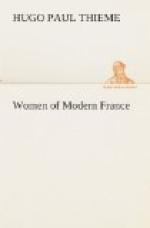At one time, the great ambition of woman was to procure a legal separation—an ambition which seems to have developed into a fad, for at one period there were over three hundred applicants for legal separation, a state of affairs which so frightened Parliament that it passed rigid laws. A striking contrast to this was the custom connected with mourning. At the death of the husband, the wife wore mourning, her entire establishment, with every article of interior furnishing, was draped in the sombre hue; she no longer went out and her house was open only to relatives and those who came to pay visits of condolence. Unless she married again, she remained in mourning all her life; but it should not be understood that the veil concealed her coquetry or prevented her from enjoying her liberty and planning her future. Then, as to-day, there were many examples of fanaticism and folly; one widow would endeavor to commit suicide; another lived with the figure of her husband in wax; another conversed, for several hours of the day, with the shade of her husband; others consecrated themselves to the church.
This all-supreme sway of love and its attributes, left its impression and lasting effect upon the physiognomy of the mistress; in the early part of the century, the mistress was chosen from the respectable aristocracy and the nobility; gradually, however, the limits of selection were extended until they included the bourgeoisie and, finally, the offspring of the common femme du peuple. A woman from any profession, from any stratum of society, by her charm and intelligence, her original discoveries and inventions of debauch and licentiousness, could easily become the heroine of the day, the goddess of society, the goal and aspiration of the used-up roues of the aristocracy. Under Louis XIV., such popularity was an impossibility to a woman of that sort, but society under the Regency seemed to have awakened from the torpor and gloom of the later years of the monarchy to a reign of unrestrained gayety and vice.
The first woman to infect the social atmosphere of the nobility with a new form of extravagance and licentiousness was Adrienne Le Couvreur, who was the heroine of the day during the first years of the Regency. She was the daughter of a hatter, who had gone to Paris about 1702; while employed as a laundress, she often gave proof of the possession of remarkable dramatic genius by her performances at private theatricals. In 1717, through the influence of the great actor Baron, she made her appearance at the Comedie Francaise; the reappearance of that favorite with Adrienne Le Couvreur as companion, in the plays of Corneille, Racine, and Voltaire, reestablished the popularity of the French theatre. Adrienne immediately became a favorite with the titled class, was frequently present at Mme. de Lambert’s, gave the most sumptuous suppers herself, and was compelled to repulse lovers of the highest nobility.




